Art and Architecture
Mayan art
The art of the Maya, as with every civilization, is a reflection of their lifestyle and culture. The mayan art was composed of delineation and painting upon paper and plaster, carvings in wood and stone, clay and stucco models, and terra cotta figurines from molds. The technical process of metal working was also highly developed but as the resources were scarce, they only created ornaments in this media. Many of the great programs of Maya art, inscriptions, and architecture were commissioned by Mayan kings to memorialize themselves and ensure their place in history. The prevailing subject of their art is not anonymous priests and unnamed gods but rather men and women of power that serve to recreate the history of the people. The works are a reflection of the society and its interaction with surrounding people.
One of the greatest shows of Mayan artistic ability and culture is the hieroglyphic stairway located at Copan. The stairway is an iconographical complex composed of statues, figures, and ramps in addition to the central stairway which together port ray many elements of Mayan society, pgint of mayan art. An alter is present as well as many pictorial references of sacrifice and their gods. More importantly than all the imagery captured with in this monument, however, is the history of the royal descent depicted in the heiroglyphs and various statues.
The figurine of a seated captive is also representative of Mayan society as it depicts someone in the process of a bloodletting ceremony, which included the accession to kingship. This figure is of high rank as depicted by his expensive earrings and intricately woven hip cloth. The rope collar which would usually mark this man as a captive, reveals that he is involved in a bloodletting rite. His genitals are exposed as he is just about to draw blood for the ceremony.
In the Indian communities, as it was with their Mayan ancestors, the basic staple diet is corn. The clothing worn is as it was in the past. It is relatively easy to determine the village in which the clothing was made by the the type of embroidery, color, design and shape. Mayan dialects of Qhuche, Cakchiquel, Kekchi, and Mam are still spoken today, although the majority of Indians also speak Spanish.
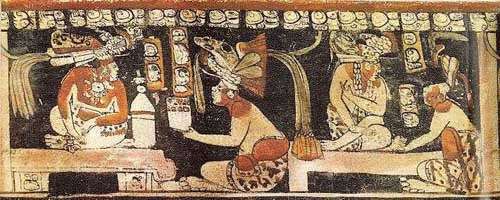
One of the most common Mayan art themes painted on Maya vases is the royal audience. The ahau, seated characteristically with legs folded, receives visitors. At times the names of the ahau and his visitors are given in glyphs. Most interesting are the details: clothing styles and decorative patterning, face painting, masks worn, gestures made and so forth. Many vases show vases as well as indicate the style of interior decor with its curtains, pillows, and thrones. Hats were of crucial importance to Maya social identity. Often the ahau receiving visitors wears a conical turban hat with a large flower in front of it and quetzal feathers behind; sometimes a hummingbird or fish is attached to the front of that large flower.
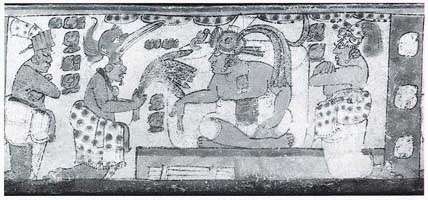
A presentation of quetzal feathers
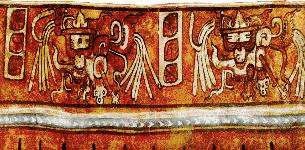
The elements on the head of this dragon are supposedly instruments of self-sacrifice They are found at the base of the supernatural tree displayed as a “cross” on Palenque temples.
The art in which above all the Maya excelled, and through which they are best known, is architecture. The splendid ruins of temples, pyramids, and great cities – some of which were intact and occupied at the time of the conquest – scattered by scores and hundreds throughout the forests of Yucatan, have been the wonder and admiration of travellers for over half a century, since they were first brought prominently to notice by Stephens.
About art of maya says Brinton: “The material was usually a hard limestone, which was polished and carved, and imbedded in a firm mortar. Such was also the character of the edifices of the Quiches and Cakchiquels of Guatemala. In view of the fact that none of these masons knew the plumb-line or the square, the accuracy of the adjustments is remarkable. Their efforts at sculpture were equally bold.
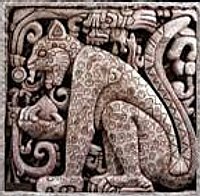 |
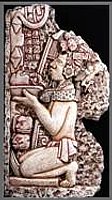 |
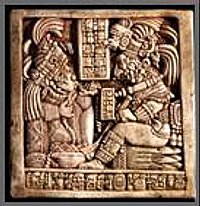 |
| added 30/01/2007 | ||
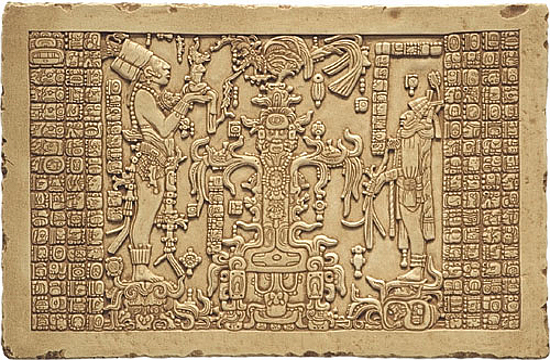 |
| The Tablet found in the Temple of the Foliated Cross, added 24/04/2012 |
They did not hesitate to attempt statues in the round of life size and larger, and the fa ades of the edifices were covered with extensive and intricate designs cut in high relief upon the stones. All this was accomplished without the use of metal tools, as they did not have even the bronze chisels familiar to the Aztecs.”
The interior walls were also frequently covered with hieroglyphic inscriptions carved in the stone or wood, or painted upon the plaster. Among the most noted of the Maya ruins are those of Palenque (in Chiapas), Uxmal, Chichen-Itz , and Maypan.
Mayan Architecture
Limestone structures, faced with lime stucco, were the hallmark of ancient Maya architecture.
The Maya developed several unique building innovations, including the corbel arch which was a false arch achieved by stepping each successive block, from opposite sides, closer to the center, and capped at the peak.
Tombs were often encased within or beneath Maya structures. Frequently new temples were built over existing structures.
A honeycombed roofcomb towered above many structures, providing a base for painted plaster that was the Maya equivalent of the billboard. In addition to temples, most Maya sites had multi-roomed structures that probably served as royal palaces as well as centers for government affairs.
Historically significant events, such as accessions, the capture or sacrifice of royal victims and the completion of the twenty year katun cycle, were recorded on stone stelae and tablets.
Without metal tools, beasts of burden, or even the wheel the Mayans were able to construct vast cities across a huge jungle landscape with an amazing degree of architectural perfection and variety.
They were noted as well for elaborate and highly decorated ceremonial architecture, including temple-pyramids, palaces and observatories, all built without metal tools.
– Pyramids of Mexico
Scientists uncover lost Mayan marketplace
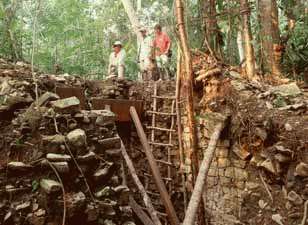
September 8, 2000 – AP – Guatemala City
Scientists and looters ignored the ruin for nearly a century because it appeared devoid of temples and burial sites that might yield valuable artifacts and treasures.
They had no idea what they were missing.